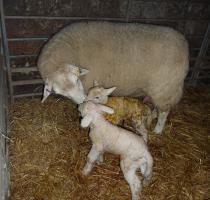This year we have been called on to do abortion investigations for a number of our flocks.
It is normal to experience a few problems right at the beginning and towards the end of lambing, and a few abortions are perhaps to be expected. It is however vital to deal with any such losses with great caution, as the potential cause may be an infectious abortion, which puts the rest of the lambing flock at risk. Therefore the minimum action you must take is as follows:
- Swiftly remove all aborted material – foetus, cleansing, contaminated straw – from contact with pregnant ewes
- Aborted material (lambs and placenta) should be kept as free from contamination as possible, bagged, and kept somewhere cool in case sampling is required - see below
- Wash your hands and protective clothing well after doing so, as you yourself may become a source of infection!
- The aborted ewe must also be separated, as she may remain a source of infection for several weeks
If the odd abortion becomes a spate of abortions, investigation may be of value. In particular, if Enzootic Abortion (EAE) is diagnosed, ewes which are still to lamb can be treated immediately; this can halt an abortion storm in its tracks.
There are two main approaches to investigating an abortion outbreak.
- Funding for blood samples checking for EAE and Toxoplasmosis is available thanks to support from a vaccine company. If you do not already vaccinate for these two important and widespread causes of abortion in sheep, then collecting samples from a dozen aborting sheep is advisable. However interpretation is not always straightforward. The blood test checks for evidence of exposure to disease, but this may have happened many months (or years) ago and not be relevant to the recent abortion. In addition, blood tests are only able to test for a limited range of diseases. This said, if the majority of ewes are positive to EAE or toxoplasmosis, this demonstrates presence of disease and suggests vaccination would likely be of production and financial benefit.
- In many cases, however, it is more helpful to sample the aborted material itself. Submitting samples from multiple abortions is often necessary to yield a diagnosis. If a number of lambs abort over a period of a couple of days these can be sampled at once and material pooled: this not only keeps lab charges down but can also increase the chance of achieving a diagnosis. Aborted material (lambs and placenta) should be kept as free from contamination as possible, bagged, and kept somewhere cool until sampling. Samples can then be taken for EAE and toxoplasmosis plus a wide range of other possible causes including Campylobacter, Salmonella, Listeria and E. coli.
